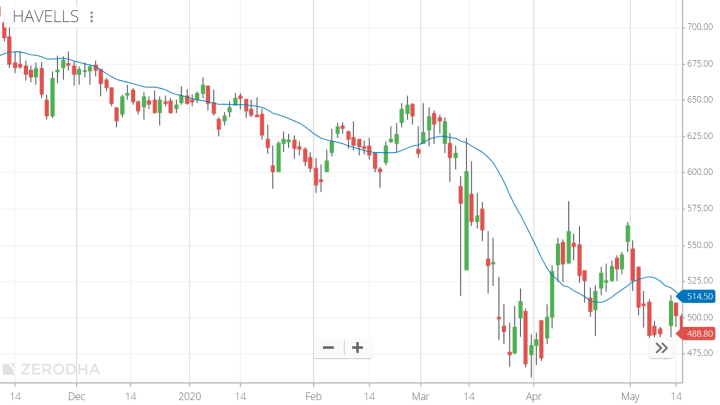All of us understand averages. It’s basically a number calculated by adding quantities together and dividing it by total number of quantities.
For example, if the temperature in Mumbai on Monday is 32 degrees, Tuesday 34 degrees and 39 degrees on Wednesday. How do we calculate the 3-day average?
We add up all the numbers: 32 + 34 + 38 = 105. The number of days is 3. To get the average we divide 105 by 3 = 35.
The average temperature in Mumbai over the last three days is 35 degrees Celsius.
Similarly, ‘Moving Average’ in stock market is the price average. It’s used as a technical indicator, which some traders use to buy and sell stocks.
On a chart, ‘Moving Average’ looks like this:

Look closely at the chart.
It’s a candlestick chart of the stock ‘Havells’. The price has been moving in a downward direction since June 2019.
The Blue colour line on the chart is the 20-day simple moving average.
The calculation is simple. The closing price of the last 20 days is added and divided by 20. This gives the average price for the last 20 days.
On the 21st day, the same process is repeated. The average of the last 20 days is taken and the line is joined.
The process is repeated everyday, which gives us a long line on the chart – along with a clear indication on how the price is moving.
Moving Average Formula
The Formula to calculate the Simple Moving Average (SMA) is like the name says – Simple.
Add closing price and divide by Number of Days
Moving Average Method used by Traders
Generally, short term traders use 8-day, 10-day or 20-day moving averages. It gives a clearer picture on the short-term trend of the stock.
Medium term traders use 50 or 100-day moving averages, while those with a longer-term view use 200-day moving average.
The ‘200 day moving average’ also called ‘200 DMA’ is quoted quite frequently on financial websites. When a stock goes below or above its ‘200 DMA’ it’s considered to be a long-term trend reversal.
Moving Averages are generally not standalone indicators. Traders use them in combination with other indicators like ‘Moving Average Convergence Divergence’ (MACD), Relative Strength Index (RSI) and other indicators.
A Moving Average can also be used with other Moving Averages. For example, a 50-day and 200-day moving average can be moving in different directions. When a stock is in an uptrend, the 50-day moving average is higher than the 200-day moving average.
However, when the 50-day moving average cuts the 200-day moving average on the downside – the stock is considered to turn bearish.

In the above chart, the Green Line is the 200-day moving average. Since the price is averaged over a long period of time – it’s smoother and flatter, because the 200-day average has been consistently around 1350 price range.
Whereas, notice how the 50-day moving average was more volatile. That’s because during the Coronavirus market crash in March 2020, the stock crashed from more than 1500 rupees per share to less than 900 per share.
On the chart, the 50-day moving average line crosses the 200-day moving average line on March 11th. Some traders use this ‘crossing of lines’ to sell their positions.
Techniques of using moving averages to trade will be discussed in more detail in another article.
Types of Moving Averages
There are two types of moving average that are commonly used on the charts.
- SMA (Simple Moving Average): It’s the calculation that we discussed in this article. The closing price is divided by the number of days.
- EMA (Exponential Moving Average): The calculation method is a little more complicated here, as more weightage is giving to the recent closing prices.


Leave a Comment